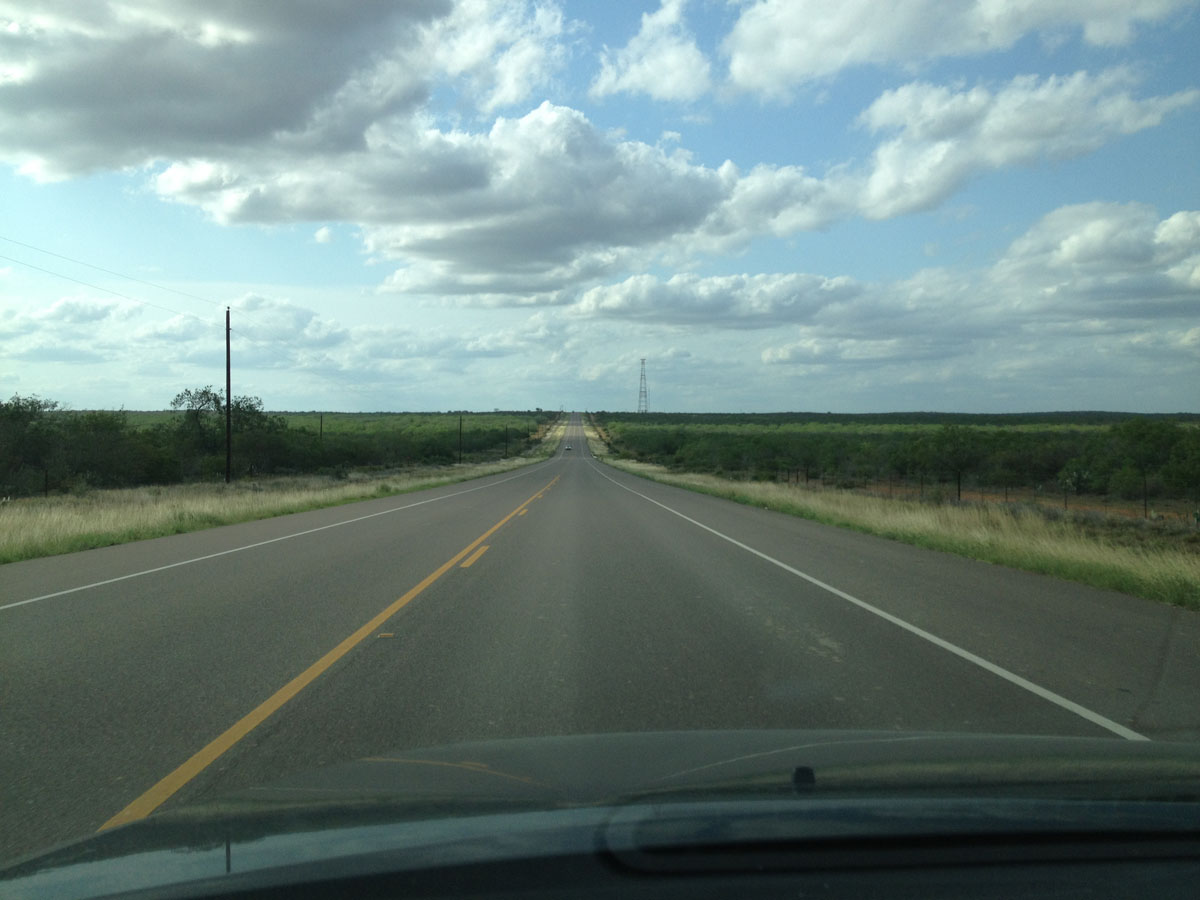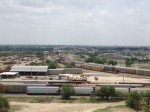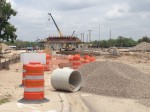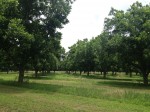Lupita and I left Laredo and drove into the undiscovered country. Both of us had been to Laredo and Nuevo Laredo several times in past. But neither one of us had been to Eagle Pass before.
We took a slight detour away from the border to head north on U.S. Highway 83, the same highway that goes through the Rio Grande Valley and continues through the heart of Texas and all the way north to the Canadian border.

The bleak highway between Laredo and Eagle Pass is filled with shrub buses, natural gas well and oil wells. (Sergio Chapa/Borderzine.com)
But we were only taking it to Carrizo Springs.
Eagle Ford shale
Just north of Laredo, Highway 83 is a sun-bleached road where the vegetation turns from mesquite forest to thorny scrub brush.
Unlike the vast brush country of deep-South Texas, there are not vast groups of immigrants crossing to bypass Border Patrol checkpoints.
Immigrants and drugs are mostly carried aboard 18-wheelers and cars along Interstate 35, which runs parallel to Highway 83 and heads north to San Antonio and other destinations.
The rolling hills were only interrupted by oil and natural gas wells, which provide the only shade among the squat thorn bushes. Those oil and natural gas wells are all extracting energy from the Eagle Ford Formation, a pre-historic sedimentary rock formation.
Many thought the oil and natural gas inside the formation was too expensive to extract until 2008. But a new extraction process known as hydraulic fracturing or “fracking” has unlocked energy deep inside the rock.
Although it has never been scientifically proven, environmentalists have blamed fracking for groundwater contamination, earthquakes and other problems. But for the people along Highway 83, the new oil and natural gas boom means jobs and development.
Carrizo Springs
We drove through rural communities of Catarina and Asherton where the towns have a new lease on life.
Companies that supply machinery and raw materials for the oil and natural gas wells have sprung in a short matter of time. The influx of pipeline and oil field workers has maximized hotel occupancy rates and stretched the real estate market thin.
Rental prices have skyrocketed in the area with some workers renting modest homes for thousands of dollars a month. To meet the demand for housing, some companies have cleared land to build mobile home parks for workers.
With workers toiling from sunrise to sunset, those mobile home parks include entertainment facilities to keep workers close and out of trouble.
Eagle Pass
Our trip continued west from Carrizo Springs and west on U.S. Highway 277 to the border community of Eagle Pass.
We rolled through flatlands dotted with more oil and natural gas wells. The only interruption was a Border Patrol checkpoint on the westbound lanes but we arrived to the town of 27,000 people late in the afternoon.
One of the first things we saw was a massive stadium built for the Eagle Pass Eagles, a local high school football team. It was summertime and 100 degrees but the heat didn’t seem as bad with the arid region’s low humidity.
We sent straight through town and headed straight for the Eagle Pass International Bridge. Parking our rental car on the American side of the border, we walked across the long bridge both amazed by sights we had never seen. Below the international bridge on the American side is a vast green park that includes a golf course and soccer fields. We stopped to watch children playing soccer along the Rio Grande River.
Here, the mighty Rio Grande was wide but appeared shallow, rocky, swift and clean unlike other polluted areas we had seen in Laredo. As we crossed the borderline into Mexico, we arrived just before sunset but the sky was already turning from blue to an amazing color of red.
Piedras Negras
This town in the state of Coahuila is firmly behind enemy lines and controlled by the ruthless Zetas drug cartel. The beautiful border city of 150,000 people is part of what’s known as the “Frontera Blanca” or “White Border.”
Known for people of deep Catholic faith, the region was always considered one of the most peaceful along the border where, as the motto goes, “No Pasa Nada,” nothing ever happens.
Seemingly peaceful on the surface, over the past decade the Zetas took over drug and human smuggling routes in the Piedras Negras area, as well as kidnapping and extortion rackets.
The U.S. Consulate in Nuevo Laredo issued a series of alerts over the past couple of years warning travelers of narco blockades and gun battles.
Mindful of the violence, we slipped into town as pedestrians across the bridge hoping to go unnoticed.
But the new sights quickly had us shift into tourist mode. We were amazed by the cleanliness of the city where there was not even a piece of litter on the ground.
Lupita and I joined families strolling along the “Paseo del Rio” or Riverwalk, a concrete trail and scenic overlook along the Rio Grande River. Families were peacefully enjoying the evening running and playing.
We snapped photos of beautiful monuments and a cathedral.
One of my favorite monuments was “El Monumento de las Golondrinas,” the Monument of the Swallows. The glass and steel monument pays homage to the tiny birds that make their homes in mud nests under the area’s international bridges.
Kickapoo Casino
Back on the American side of the border, we took a late night trip to the Kickapoo Indian Reservation and the Lucky Eagle Casino.
Texas only has three tiny Indian reservations: the Tigua Ysleta del Sur Reservation in El Paso, the Alabama-Coushatta Reservation in East Texas and the Kickapoo in Eagle Pass.
A century ago, the Kickapoo originally roamed the rolling hills of Wisconsin but migrated across the Great Plains ending up in Texas and northern Mexico.
The now-defunct Texas Commission for Indian Affairs recognized the tribe in 1977 with the federal government granting them 118 acres of land in 1985. Today, the reservation is best known for the Lucky Eagle Casino, which now includes its own hotel.
Lupita and I were hoping for Las Vegas-style roulette and craps but the casino only has poker and slot machines.
Border Beauty
We woke up early the next morning to go running at the park along the Rio Grande River where we were the only ones there. Our route took us along the border fence, which in this location is black steel instead of the rust-colored steel seen at many other areas of the border.
The only other people we saw were Border Patrol agents launching boats in the river or patrolling the banks in their SUVs. We saw a father and son playing golf along the Rio Grande River, oblivious to the Mexican side of the border.
After a hearty breakfast, we took a drive along a border highway with arid hills but we followed a curve and found an oasis of green. At this location, pecan farmers who grow vast orchard with tall trees and green grass irrigate the fertile soil along the river.
We reminded ourselves that beauty is in the eye of beholder when we stopped by the international rail bridge, and another bridge just for 18-wheelers.
Before leaving town, Lupita and I stopped at a hill overlooking the rail yards and were impressed by the high volume of train traffic. We also got to see a highway expansion project that will move visitors quickly to the casino.
On our way out of town, we took a trip up Main Street to see the historic building and quaint shops. My favorite was the Eagle Grocery, which is known as “La Tienda de los Venados,” the Store of the Deer because of its numerous deer head hunting trophies inside.
Burgos Basin
Leaving town, we remarked that the Eagle Ford Formation’s natural wealth doesn’t stop at the border. Oil, natural gas and coal can be found in what is known as Mexico’s Burgos Basin, also known as the Boquillas Formation.
Just south of Eagle Pass, Coahuila is a state of great mineral wealth with coal and other exports. But like other areas of the border, the mineral wealth is caught in the crossfire of Mexico’s drug war.
Lupita and I noted that the areas with the greatest oil, natural gas and mineral wealth seem to be those with the greatest drug cartel violence. It’s a story we have seen repeated all they way from the Rio Grande Valley to this beautiful corner of the border.
- A Border Patrol checkpoint along the highway between Carrizo Springs and Eagle Pass. (Sergio Chapa/Borderzine.com)
- The Dimmitt County Courthouse in Carrizo Springs. (Sergio Chapa/Borderzine.com)
- Oil & natural gas companies have created a building boom in towns like Catarina, Asherton and Carrizo Springs. (Sergio Chapa/Borderzine.com)
- The bleak highway between Laredo and Eagle Pass is filled with shrub buses, natural gas well and oil wells. (Sergio Chapa/Borderzine.com)































Nice blog, but you need to double check your facts. You can tell you were just reading road signs and looked up some quick info on google.
Mas o menos!
Nice article. As for commenter Kevin– what a douche. “You can tell you were just reading road signs…” Oh, can you? Can you tell that? Gosh, you’re cool.
Hi Sergio – thanks for this blog.
I’m looking to travel to Eagle pass at the end of August with my girlfriend and want to cross in the day to Piedras Negras but am slightly concerned about safety.
Do you think this is an issue? I read things all the time but it’s better to get an understanding from someone who has actually been there quite recently.
Any advise you have would be most helpful
Thanks